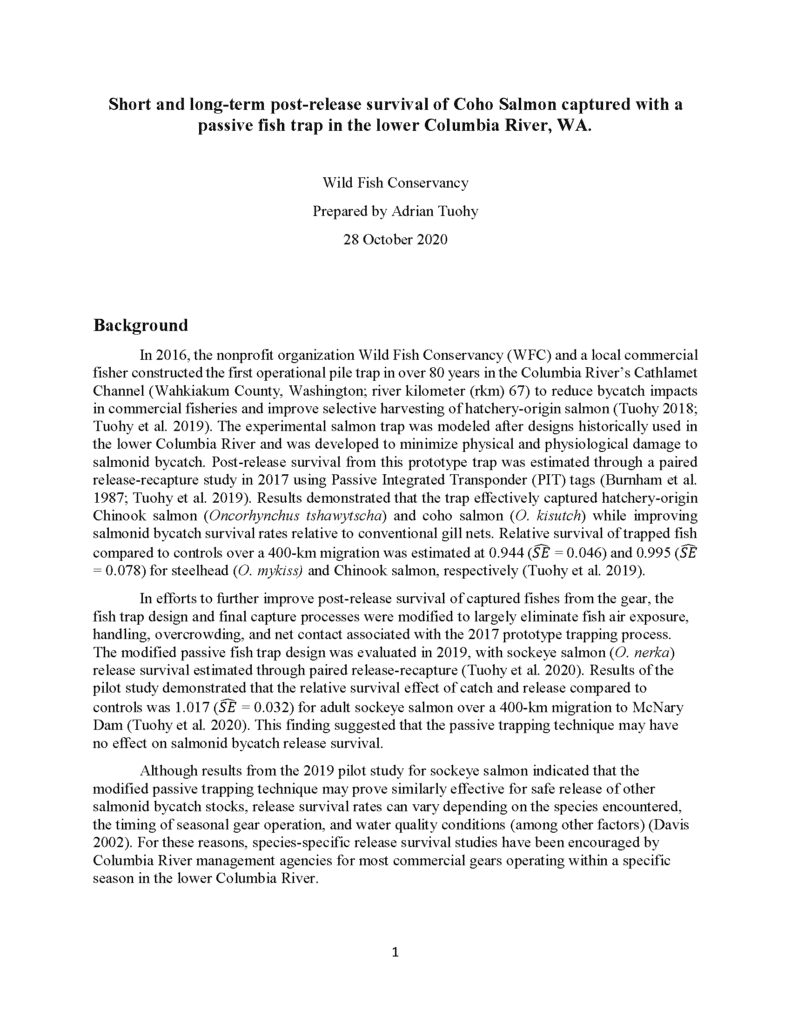
Description |
|---|
In 2016, the nonprofit organization Wild Fish Conservancy (WFC) and a local commercial fisher constructed the first operational pile trap in over 80 years in the Columbia River’s Cathlamet Channel (Wahkiakum County, Washington; river kilometer (rkm) 67) to reduce bycatch impacts in commercial fisheries and improve selective harvesting of hatchery-origin salmon (Tuohy 2018; Tuohy et al. 2019). The experimental salmon trap was modeled after designs historically used in the lower Columbia River and was developed to minimize physical and physiological damage to salmonid bycatch. Post-release survival from this prototype trap was estimated through a paired release-recapture study in 2017 using Passive Integrated Transponder (PIT) tags (Burnham et al. 1987; Tuohy et al. 2019). Results demonstrated that the trap effectively captured hatchery-origin Chinook salmon (Oncorhynchus tshawytscha) and coho salmon (O. kisutch) while improving salmonid bycatch survival rates relative to conventional gill nets. Relative survival of trapped fish compared to controls over a 400-km migration was estimated at 0.944 (𝑆𝐸̂ = 0.046) and 0.995 (𝑆𝐸̂= 0.078) for steelhead (O. mykiss) and Chinook salmon, respectively (Tuohy et al. 2019). In efforts to further improve post-release survival of captured fishes from the gear, the fish trap design and final capture processes were modified to largely eliminate fish air exposure, handling, overcrowding, and net contact associated with the 2017 prototype trapping process. The modified passive fish trap design was evaluated in 2019, with sockeye salmon (O. nerka) release survival estimated through paired release-recapture (Tuohy et al. 2020). Results of the pilot study demonstrated that the relative survival effect of catch and release compared to controls was 1.017 (𝑆𝐸̂ = 0.032) for adult sockeye salmon over a 400-km migration to McNary Dam (Tuohy et al. 2020). This finding suggested that the passive trapping technique may have no effect on salmonid bycatch release survival. Although results from the 2019 pilot study for sockeye salmon indicated that the modified passive trapping technique may prove similarly effective for safe release of other salmonid bycatch stocks, release survival rates can vary depending on the species encountered, the timing of seasonal gear operation, and water quality conditions (among other factors) (Davis 2002). For these reasons, species-specific release survival studies have been encouraged by Columbia River management agencies for most commercial gears operating within a specific season in the lower Columbia River. |
File Attachment |
|---|
Download |
Join our mailing list to recieve important updates on our work, the latest wild fish news, & opportunities to take action to support wild fish.
This site is protected by reCAPTCHA and the Google Privacy Policy and Terms of Service apply.
Wild Fish Conservancy is recognized as a 501(c)3 non-profit by the IRS